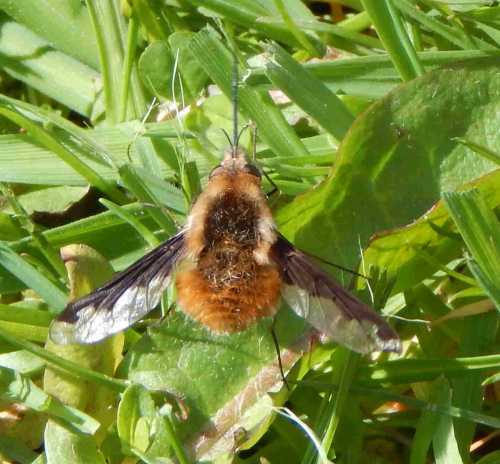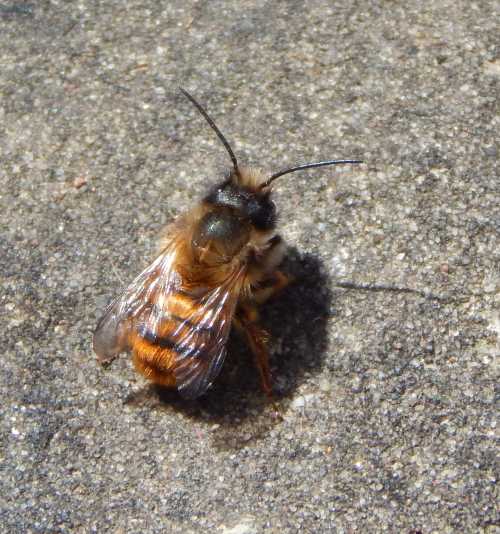Marsham's Nomad Bee - Nomada marshamella
Updated: 23rd February 2021
A couple of days ago, I snapped a few photographs of another Nomada bee species - this one being a female Nomada marshamella (Marsham's nomad bee) flying and lurking around an old wall that is home to a variety of solitary bee species.
I take walks almost daily, and pass this wall on a regular basis. Indeed, I have observed many bee species around the wall and flora surrounding it at various times of the year. This wall has the blessing of sunshine for a large part of the day, and all manner of pretty flowers grow from the crevices. Ivy also provides shelter and camouflage - but nomad bees seem to have little trouble finding potential hosts (nomad bees being cleptoparasites).
I don't always have my camera with me - but on this day, I had it on my shoulder 'just in case'.
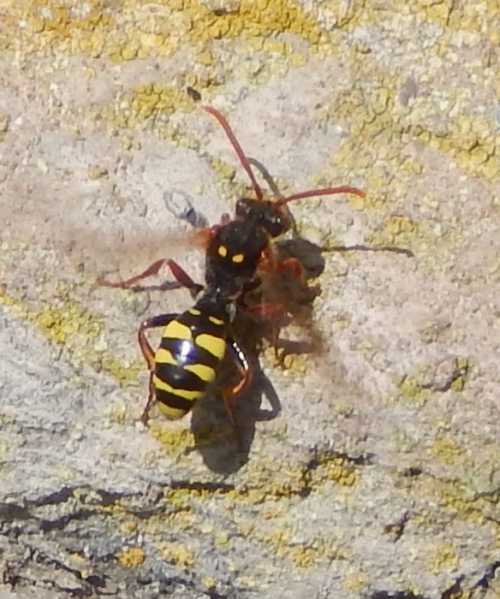 Nomada marshamella female on a wall. The second segment of yellow closest to the thorax, is split by the black marking.
Nomada marshamella female on a wall. The second segment of yellow closest to the thorax, is split by the black marking.
About Marsham's Nomad Bee - Nomada marshamella
This nomad bee is black and yellow, and you can see two distinctive yellow spots on the thorax. The antennae are orange. The legs are mostly orange with some black visible on the femora.
The Marsham's nomad bee can easily be mistaken for the Gooden's nomad bee. The easiest way to tell them apart is by looking at the segments on the abdomen. In Marsham's nomad bee, the second segment of yellow closest to the thorax, is split by the black marking.
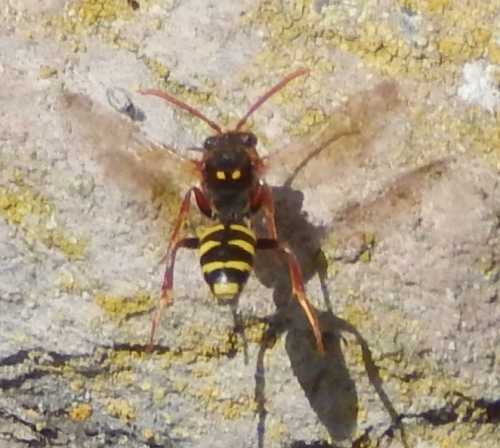 Nomada marshamella female about to land, showing a rear view of the body markings.
Nomada marshamella female about to land, showing a rear view of the body markings.In Gooden's nomad bee, there is no actual break in the second yellow segment, instead it is a continuous yellow marking.
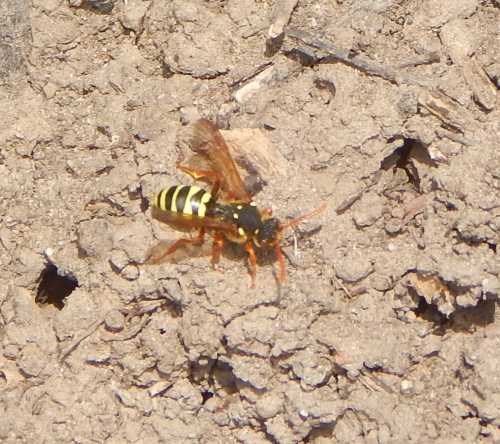 Female Gooden's nomad bee - Nomada goodeniana. There is no break in the second yellow segment on the abdomen.
Female Gooden's nomad bee - Nomada goodeniana. There is no break in the second yellow segment on the abdomen.
Marsham's nomad bee flight season and foraging preferences
Depending on your location, Marsham's nomad bee are seen from April through to June or even up to August. Much will depend on the presence and abundance of host species and flight period of the host species in the area.
In terms of floral preference, they will feed on a wide variety of shrubs, herbs and plants.
Marsham's nomad bee host species preferences
Like all nomad bee species, the Marsham's nomad bee is a cleptoparasite. It lurks around the nest entrances of target host species, waiting for the optimum time to enter the nest, lay an egg in the cell wall, then leave. Its offspring will develop more quickly than that of the host, which it will destroy with its jaws. It will gobble up the food supply intended for the young of the developing host bee.
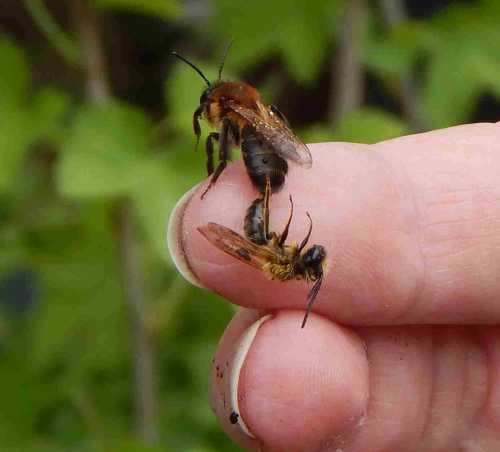 Two Andrena scotica - chocolate mining bees, mating. Andrena scotica is a target host species of Nomada marshamella.
Two Andrena scotica - chocolate mining bees, mating. Andrena scotica is a target host species of Nomada marshamella.
According to Falk, Nomada marshamella are known to target Andrena scotica (Chocolate mining bee), and possibly Andrena trimmerana (Trimmer's mining bee), Andrena rosae (Perkin's mining bee) and Andrena ferox (Oak mining bee).
Looking out for Nomada bee species
I have previously written that when you learn to recognize nomad bee species, you soon realize that the host bee (a solitary species of some kind) is likely to be nesting near by. It's also true that if you are a 'bee enthusiast' like me, and you wish to see Nomada species, it's a good idea to look around the areas where you know the host species nests, or is likely to nest.
For me, I first learned some years ago that solitary bees were to be found nesting this area of wall, and after that I began to notice the nomad bee species around it. Indeed, a sunny wall with lots of crevices and holes is a good place to go 'bee spotting'.
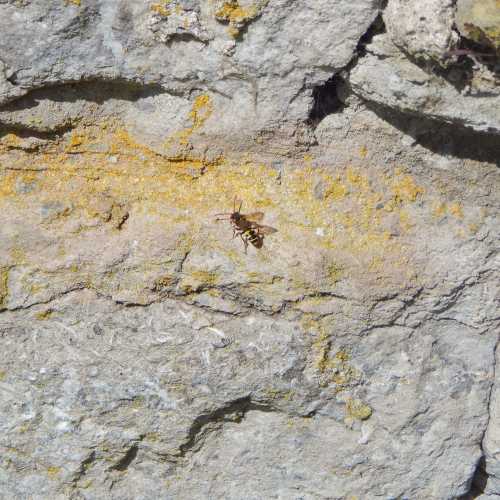 Marsham's nomad bee can be found around sites where host species might nest.
Marsham's nomad bee can be found around sites where host species might nest.
Cleptoparasites depend on a healthy, abundant host population
I can understand people not being very keen on the idea of cleptoparastic bee species - after all, who likes a parasite of any kind? I have come to realize that the parasites need a healthy population of hosts in order to survive.
However, I must admit that what I am not sure about is the balance: can the balance of the cleptoparasites outweigh the balance of the host species to the point that it harms both?
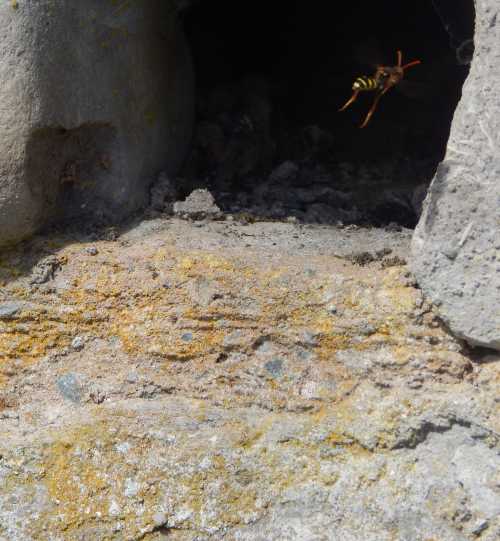 Marsham's nomad bee appearing to investigate a possible host nest inside a wall cavity.
Marsham's nomad bee appearing to investigate a possible host nest inside a wall cavity.From a purely detached point of view, I used to think that this was unlikely, however, I have come to realize that the subject is not so simple.
If a cleptoparasite is adaptable in terms of potential host and foraging requirements, I suspect there could be scope for imbalance. If one host species is in significant decline (perhaps due to habitat loss, for example), the cleptoparasites will target the other species within their repertoire of possible hosts, hence putting other species under more pressure.
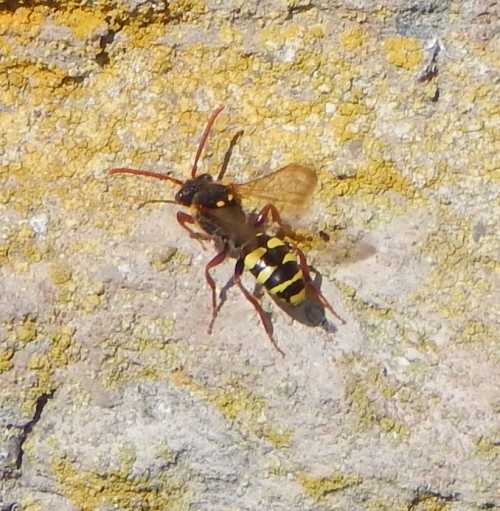 Marsham's nomad bees are cleptoparasites.
Marsham's nomad bees are cleptoparasites.
In ecological terms then, if a target host suffers from other negative environmental factors that hamper its ability to thrive, the parasitic species may well hamper it further - and also other target hosts, ultimately to the detriment of both.
So what can we do?
- We can continue to first concentrate on making our own gardens as 'bee friendly' as possible,
- In our gardens, we can select a range of plants and shrubs attractive to bees.
Creating and protecting habitats and refraining from the use of toxic chemicals, is the way to help all bee species.
Read about the Chocolate Mining Bee
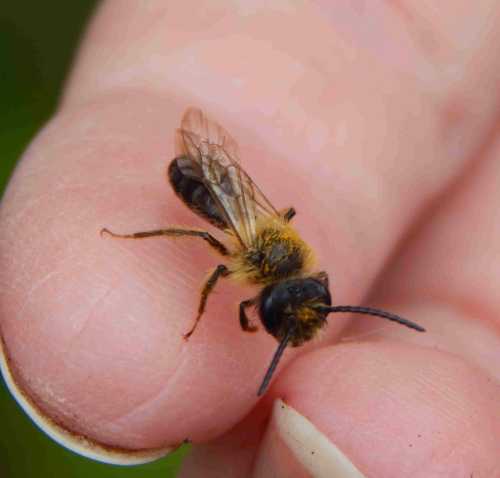
If you found this page helpful or interesting, I'd really be grateful if you would share it with others - if not this page, perhaps another, such as Gardening For Bees.
Thank you so much :) .
